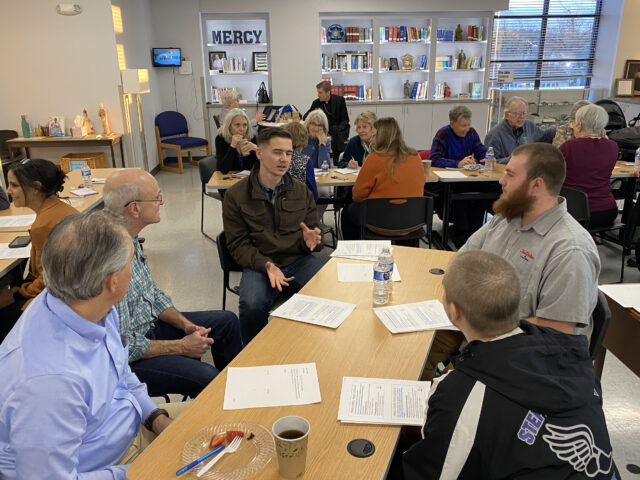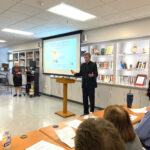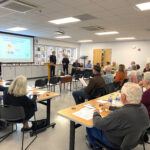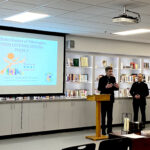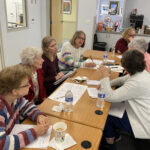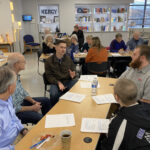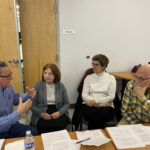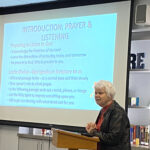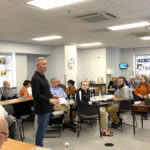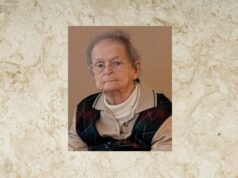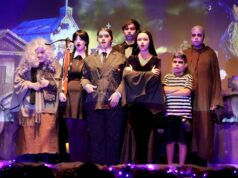SALISBURY – The process was as important – if not more so – as the final product during the second 2024 diocesan Synod listening session Monday evening, March 18, at St. Francis de Sales Catholic Parish in Salisbury, Md.
About 50 people from various churches in the Diocese of Wilmington attended the southern session. A prior listening session was held March 4 at St. Margaret of Scotland Parish in Glasgow, at the northern end of the Diocese of Wilmington.
Participants formed small groups and put into practice the three elements of the 2021-2023 Synod: Communion, Participation and Mission.
Facilitating the listening session were the Rev. Brian Lewis, pastor of St. Jude the Apostle Parish in Lewes, and Sister Ann David Strohminger, diocesan Delegate for Religious.
Although a final summary report was published in August 2022, Pope Francis extended the Synod, which began in 2021, for another year through 2024, “to deepen discernment, because synodality is really about discerning together, listening to each other, listening to the Holy Spirit,” said Sister Nathalie Becquart, one of two undersecretaries of the General Secretariat of the Synod appointed by Pope Francis, according to Vatican News.
Extending the synodal process by an extra year will allow for a greater “time of maturation,” Sr. Becquart said. Inviting the global Catholic Church to reflect on walking together and listening to one another, Pope Francis opened the celebration of the Synod October 2021 in Rome.
This “Synod on Synodality” has been a two-year process that began with local dioceses and parishes engaging in dialogue through listening sessions, according to the U.S. Conference of Catholic Bishops (USCCB).
Each diocese then prepared a report of what was heard at these sessions, and those local reports were then sent to the USCCB. A national summary was created and sent to the Holy See August 29, 2022.
The Synod proceeded through three phases: The Diocesan Phase, October 2021 to April 2022; the Continental Phase, May 2022 to March 2023; and the Synod of Bishops in October 2023.
An estimated 700,000 people participated in the diocesan phase of the Synod in the United States.
In the Diocese of Wilmington, prior to the last two sessions in 2024, 51 listening sessions took place involving over 1,400 people, as well as 41 completing an online survey. “Admittedly, this is not wholly comprehensive as there are estimated to be over 250,000 Catholics in the Diocese of Wilmington and many more subcategories and classes of people that could have been consulted,” the final summary report stated.
The “purpose of the Synod is to be an ongoing process that changes the style and approach of the Church,” and participants in Salisbury echoed existing themes and “best practices” recommended in the 2022 final summary report of the diocese.
The “strong majority of preexisting organizations and structures were sampled or at least approached to participate,” the report stated. “The Synod on Synodality is a beginning not an end; it is an ongoing effort to ensure all are able to journey together by the guidance of the Holy Spirit to God’s Kingdom in heaven.”
About one or two months ago, the Holy Father asked the dioceses to hold another group of meetings, Bishop Koenig said. He added that his role was “just to listen.”
While small groups worked together, Bishop Koenig said participants’ venturing beyond their deanery listening sessions “gives them a bigger perspective.”
Each group of five was directed to choose a group leader and a reporter. Clergy who attended were advised to be active listeners rather than participants.
Participants were asked to listen to the Holy Spirit and to each other in nonjudgmental charity, and Scripture and prayer formed the basis for their discussions of “successes and distresses within the church’s structures, organization, leadership and life that encourage or hinder the mission,” Sister Ann David said. Groups also were directed to propose action steps.
Successes reported by the groups included evangelization through service, spiritual growth through participation in the sacraments, the Church’s “deep history and traditions,” greeting and welcoming people to help them feel included, being able to have open and frank conversations inspired by the Synod model, and greater involvement of youth, women and the Hispanic community.
Groups said distresses were a lack of unity both in understanding the faith and among cultural backgrounds, visitors not being assimilated into the life of the local church, the lack of inclusion of non-native cultures, the shortage of priests, changes in pastoral leadership, the “controlling priest who insists on having everything his way,” lack of empowering the laity and a need to expand “ordination to all baptized adults.”
Among the action steps suggested were meaningful small groups, hiring parish administrators, focusing on youth, sharing resources and successes that can be replicated in other parishes, offering more adult formation, post-seminary continuing education for priests, having a more effective online presence, and improved communication within the diocese.
For more information on the Synod, visit usccb.org/synod.


